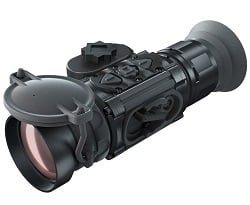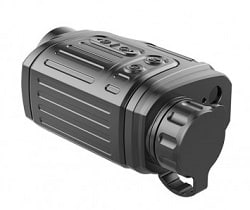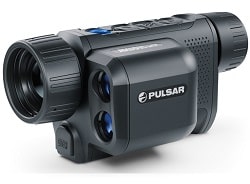Which thermal imager to buy for hunting: review and rating of the TOP-4 best monoculars in 2024
The article discusses the best models of thermal imagers for hunting. Description, specifications, pros and cons are given
Thermal imagers are devices that respond to infrared radiation, which is released with body heat. The human eye cannot see it.
The thermal imager, due to germanium-coated optics, captures this radiation and feeds it to the matrix. As a result, the silhouette of a living being is drawn.
This device is an optimal alternative to another analogue for those who want to improve the performance of weapons without investing large sums.
Thermal imagers are not blinded by a sudden appearance of light.
The following is a rating of the best models of thermal imagers for hunting, which have optimal characteristics and positive reviews.
How to choose the right thermal imager for hunting?
To choose the right thermal imager, you need to understand its characteristics. These include:
- Matrix resolution.
There are two types on the market: 640x480 and 384x288.
The object will be easier to see and the picture will be clearer, the more pixels and higher the resolution of the device. - Lens size.
It affects aperture, extreme and angle of view.
The larger the lens, the higher the magnification.
Therefore, a device with a large lens size distinguishes the target at a greater distance.
However, it is inconvenient to use such a device at a short distance.
- Frame frequency.
Modern models have a frame rate of 30 and 50 hertz.
For comfortable perception by the eye, a frequency of 25 frames per second is sufficient.
At a high frame rate, any object is clearly visible. - Spectral sensitivity range, µm.
Most handheld thermal cameras have a spectral range.
Such devices do not require cooling, which can significantly reduce their weight.
Shortwave thermal imagers, 3-5 µm, have more weight because they are cooled.
Such devices can only be used permanently. - The material of the objective lens of a thermal imaging sight.
In all lenses of thermal imaging sights, lenses are made of germanium, coated on the outside with a thin layer of titanium alloy.
Such lenses are capable of transmitting only infrared wavelengths.
Therefore, when choosing a specific model of a thermal imager, you should first consult with a specialist.
Overview of the best models
Rating of the best thermal cameras for hunting in terms of price and quality.
Thermal imaging device Fortuna General 40M6
Thermal imaging device Fortuna General 40 MB is a powerful updated device, which is distinguished by improved technical parameters.

This model is protected from sudden temperature changes, shocks and falls.
The device has high performance under any conditions. It adapts perfectly to almost any weapon.
The considered model from the company Fortuna fully complies with the highest quality standards. It can be used professionally.
Specifications:
- thermal imaging module, pix: 640×480 (17 µm);
- spectral range, microns: 7.5-14;
- frequency, Hz: 25;
- sensitivity, mK: < 50;
- calibration: silent, electronic;
- lens, mm: 40.
Advantages
- affordable price;
- the ability to detect a source at any time of the day or night;
- convenient controls;
- the ability to work under any climatic conditions;
- the device can be connected to additional power sources.
Flaws
- not identified.
Thermal imaging monocular iRay Finder FH25R with laser rangefinder
In this model, the lens is made of the purest Germany with the highest purification. This allows you to get the most accurate result.

Provides manual adjustment of the focal length. With it, a clear image is possible over the entire detection distance.
A built-in recorder is provided. It allows you to record videos and take photos. Recordings can be made to the built-in memory.
It is also possible to connect a mobile device for data transfer via Wi-Fi.
Specifications:
- thermal imaging module, pix: 640×512;
- spectral range, microns: 7.5-14;
- frequency, Hz: 50;
- sensitivity, mK: < 50;
- calibration: silent, electronic;
- lens, mm: 25.
Advantages
- the ability to use the device under any conditions;
- convenient controls;
- availability of video and photos;
- quality image display.
Flaws
- high price.
Thermal Imaging Monocular Pulsar Axion XQ38 LRF
The thermal imager with a rangefinder Pulsar Axion LRF XQ38 is a modern model of a new generation.

The device is able to see through snow, fog and tree branches.
With it, it is possible to detect a person and an animal in complete darkness at a distance of 1,000 meters.
Weather conditions do not affect image quality. The thermal imager will record the slightest differences in temperature differences of the observed objects, despite the cold, rain, snowfall or fog.
If the device is not used for more than three seconds, it will automatically turn off. The body is made of magnesium. It is resistant to temperature extremes, shock and vibration.
Specifications:
- thermal imaging module, pix: 384×288;
- spectral range, microns: 8-14;
- frequency, Hz: 50;
- sensitivity, mK: < 35;
- calibration: silent, electronic;
- lens, mm: 35.
Advantages
- the ability to use the device under any conditions;
- convenient application;
- durable and lightweight body;
- affordable cost.
Flaws
- not identified.
Thermal Imaging Monocular Hikmicro OWL OH35
The menu provides a function for tracking hot objects. In total, the device highlights four areas with the highest temperature: hot white / hot black / hot red / color mode.

Convenient application. The device is easily located in a jacket pocket.
Has a solid body. The device is protected from moisture and dust by 90%. Even with a short-term immersion to a depth, the device is reliably protected from moisture.
Specifications:
- thermal imaging module, pix: 384×288;
- spectral range, microns: 7.5-17;
- frequency, Hz: 50;
- sensitivity, mK: < 50;
- calibration: silent, electronic;
- lens, mm: 25.
Advantages
- the ability to record on the built-in memory;
- convenient application;
- durable case;
- reliable protection against moisture and dust.
Flaws
- high price.
Reviews
This review has no replies yet.
Useful video
From this video you will learn what to look for when choosing a thermal imager for hunting:

conclusions
Thus, there are various models of thermal imagers. Each of them has its own characteristics, advantages and disadvantages.
It is necessary to select a specific model based on the conditions of use of the device and based on your own preferences.

 However, it is inconvenient to use such a device at a short distance.
However, it is inconvenient to use such a device at a short distance.